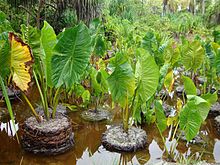Cyrtosperma merkusii
| Cyrtosperma merkusii | |
|---|---|

| |
| Babai cultivation in Butaritari, Kiribati. | |
| Scientific classification | |
| Kingdom: | Plantae |
| Clade: | Tracheophytes |
| Clade: | Angiosperms |
| Clade: | Monocots |
| Order: | Alismatales |
| Family: | Araceae |
| Genus: | Cyrtosperma |
| Species: | C. merkusii
|
| Binomial name | |
| Cyrtosperma merkusii (Hassk.) Schott
| |
| Synonyms | |
| |
Cyrtosperma merkusii or giant swamp taro, is a
The same species is also known by the names Cyrtosperma lasioides, Cyrtosperma chamissonis and Cyrtosperma edule.[4]
In the harsh
In Nepal, Giant Swamp Taro is called mane and grows in the tropical and sub tropical forests along stream banks. It is gathered in January–February and all plant parts (leaf, stem, rhizomes) are savored after being boiled and roasted. The stem requires prolonged boiling and the water is replaced once to remove irritating chemicals. If cooked carefully, the rhizomes taste like taro and the leaves like spinach. But without careful washing, the food causes an unpleasant tingling or scratchy sensation.[8]
Species
Giant swamp taro is the largest of the root crop plants known collectively as
Cultivation
Giant swamp taro is not suitable for growing in upland or rainfed conditions; it has adapted to growth within fresh water and coastal swamps. It exhibits some shade tolerance and is considered mildly tolerant of saline growing conditions compared to other taro species; that is, it can be grown in mildly brackish water. It is a slow growing crop which can take up to 15 years to mature.
Giant swamp taro is nearly the only
In the
Preparation
Giant swamp taro contains
In the Philippines where this grows in swamps or marshes, the corms are harvested for food. It is left to grow for years and signs that it has enough corms when the mother stems have fewer leaves and it has reached a sizable size with tubers. The harvested corms are cooked for food which is starchy. Unlike taro and eddo, it is not purposely cultivated for its starchy corm for food. It usually grows in the wild in swampy areas and marshes. It is called Palawan by Waray people where it is most popular as an edible food.
See also
References
- ^ "Tuvalu could lose root crop". Radio New Zealand. 17 September 2008. Retrieved 10 May 2010.
- ^ "Leaflet No. 1 - Revised 1992 - Taro". Food and Agriculture Organization. Archived from the original on 28 August 2009. Retrieved 10 May 2010.
- ^ FAO.
- ^ "ITIS report, Cyrtosperma merkusii". Integrated Taxonomic Information System.
- ^ Koch, Gerd (1983–1990). The material culture of Tuvalu. Institute of Pacific Studies, University of the South Pacific. p. 46. Retrieved 12 May 2010.
- ^ ISBN 978-982-02-0008-1.
- ^ a b Gorišek, Saša (April 2010). "Tuvalu Food Security" (PDF). United Nations. Retrieved 12 May 2010.
- ^ Limbu, Prakash (2012). Nepal Food Culture (PDF). ICIMOD [Kathmandu Nepal]. Archived from the original (PDF) on 2016-03-04. Retrieved 2014-09-18.
- ^ "Root Crops/29".
- ^ Deni Bown, AROIDS - PLANTS OF THE ARUM FAMILY (Portland: Timber Press, 2000 revised edit.) p. 265.
- ^ "Plants & Environments of the Marshall Islands". Archived from the original on 2017-01-21. Retrieved 2017-02-23.
- ^ http://www.germanwatch.org/download/klak/Fb_tuv_e.pdf[permanent dead link]
- ^ Knox, Angie (28 August 2002). "Sinking feeling in Tuvalu". BBC News. Retrieved 10 May 2010.
- ^ Corlett, David (27 November 2008). "Tuvalunacy, or the real thing?". Inside. Retrieved 12 May 2010.
- ^ "Palauan". Philippine Medicinal Plants. Retrieved 16 May 2020.
- ^ Damo, Ida. "Siargao's Hopyaw". ChoosePhilippines. Retrieved 16 May 2020.
